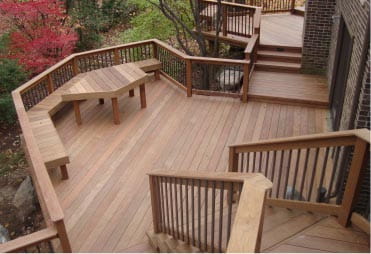Things to do to Keep the Snow From Deck Damage
In the midst of winter, it's hard not to look forward to spring when the snow will melt, and it will be time to pull out the patio set, fire up the grill, and relax with a cold beverage.
But what if winter leaves your deck splintered, warped, or faded, dulling the thrill of thawing temperatures?
Frightening, isn't it? A little prep and post-winter deck maintenance will have your deck all set to host backyard barbecues in no time. Here's a quick rundown on deck repair and how to avoid damage this winter.
Always Be Prepared
There are steps you can take to avoid the many problems caused by snow sitting on your deck.
- Sweep away dirt or debris before the first snowfall. Also, remove any leaves, pine needles, or other organic materials between deck boards.
- Remove any planters or pots. These drainage holes typically leave moisture between the pots and the deck's surface.
- Wash the entire deck and clean off any mildew. Kill the mildew on the deck using water, oxygen bleach, and liquid soap.
- Use three cups of water, one cup of bleach, and a few squirts of soap.
- Put the mixture into a spray bottle and spray any affected areas.
- Wait 20 to 30 minutes, then rinse with water. Repeat as necessary and use a plastic bristle brush for stubborn mildew patches.
This will limit moisture buildup and eliminate any pre-existing problems that go undetected under a blanket of snow.
Don't Over-Shovel
It is tempting to remove large piles of snow to protect the deck from moisture; regular snow shoveling does more harm than good.
Improper snow shoveling could leave the deck with scrapes or gouges---and big deck repair bills in the spring. Shoveling is most needed when an exit route from the back door needs to be created and snow gets higher than deck rails.
If chosen to shovel, always shovel in a path parallel to the deck boards, not perpendicular. Going crossways will catch the edge of a board and cause damage.
Never use a metal-blade shovel on the deck because it will gouge out sections of wood or plastic. Lastly, don't use an ice chipper---even a plastic one---on the deck. If necessary, melting ice with pet-safe chemicals will have negligible impact on deck boards.
Deck Snow Removal & Melting Ice on Wood Decks
Clearing snow and melting ice from your wood deck maintains its durability and safety. Snow accumulation leads to excess moisture, causing the wood to expand and contract with temperature changes, resulting in cracks and warping. The heavy weight of snow can strain the deck's structure, potentially causing damage. Removing snow regularly keeps your deck in good condition and looking great. Consider using ice barriers for decks to prevent snow buildup in the first place.
Melting ice on your deck is also important. Ice makes the deck slippery and hazardous, increasing the wood rot and decay risk. Water from melting ice can penetrate the wood, leading to mold growth and weakening the deck over time. Using ice melt for wood decks can prevent these problems without causing damage. Avoid rock salt, harsh chemicals, or similar ice melt products that can corrode the wood. Quickly addressing snow and ice buildup ensures a safer and longer-lasting deck.
Dealing With Deck Repair
Despite best efforts, winter sometimes doesn't play fair, and wood decks may end up damaged. More severe problems, such as rotted boards or pest infestations, however, will require the assistance of a deck repair professional.
On average, homeowners spend around $1,900 to repair an entire deck after winter damage. This cost can go as low as $700 or as high as $3,100, depending on the deck's material and the extent of the problem. Termite damage and moisture rot are especially costly because the damage is typically spread over a larger area and may require foundation repair and surface corrections.
Winter can be hard on a deck---but homeowners can do just as much damage through improper or too-vigorous cleaning.
Deck Replacements Are Even More Expensive
Of course, if your deck becomes damaged beyond repair, you're going to end up spending significantly more money. How much more?
Decks.com highlights that replacing a deck costs between $25-$43 per square foot for natural wood and $30-$60 for composite materials. This means a 400-square-foot deck could cost between $10,000 and $24,000 to replace. In contrast, repairing a few damaged planks or addressing minor structural issues will likely cost significantly less, often between $570 and $2,600 for typical repairs.
According to Bob Vila, replacement is the better option if the cost of repairs exceeds half the price of a new deck. For example, minor repairs such as fixing loose boards or applying a new coat of stain can be done relatively inexpensively and can extend the life of your deck without the need for a total replacement.
Regardless, though, protecting your deck during the winter prevents the need for repairs or replacement, potentially saving you thousands of dollars.
Don't Let Winter Weather Damage the Wood on Your Deck
Prepare for the winter and save decks from possible trouble with Cedar Works. Winter can be harsh on your wood deck, but we're here to help. Ice and snow can damage your deck, leading to cracks, warping, and other issues. Our team offers tips and services to keep your deck in top condition throughout the cold months.
From snow removal and ice melt services that are safe for wooden decks, we provide everything you need to maintain your deck's beauty and usability. Whether facing a winter storm or just a regular cold snap, contact Cedar Works today for personalized advice and professional services.

